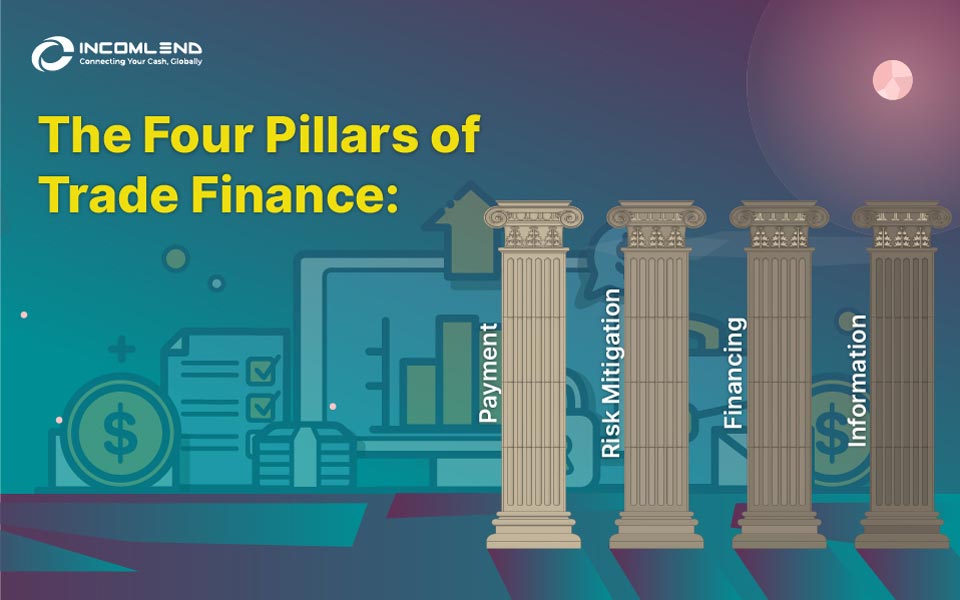The Four Pillars of Trade Finance: Payment, Risk Mitigation, Financing, and Information.
September 14, 2023
The flow of products and services across international borders is facilitated by trade financing. For international business to run smoothly and with minimal disruption, four fundamental pillars must be in place. Payment, risk management, financing, and data are the four mainstays. An effective and reliable trade financing system rests on four distinct but interrelated pillars.
1. Payment
Payment is the fundamental part of any business transaction and describes the process by which purchasers pay providers of products and services in international trade. For there to be mutual confidence between traders, the payment system must be safe, quick, and open.
Letters of Credit (LC) are widely utilised in international trade as a means of payment. A LC is a bank guarantee that the seller will be paid once the terms and conditions of the agreement have been met. As the bank of the buyer guarantees the payment upon presentation of the necessary paperwork, this creates a level of confidence between the buyer and the seller. This system reduces the seller’s exposure to non-payment, a critical issue in cross-border transactions.
2. Protecting Financial Deals from Danger
Risk mitigation is the second pillar of trade finance, and it’s crucial for shielding both buyers and sellers from the many dangers inherent in cross-border transactions. Political unpredictability, economic volatility, swings in exchange rates, and other factors all pose potential dangers. Trade ties can only survive if these dangers are reduced as much as possible.
Trade credit insurance is a frequent method for reducing exposure to risk. This insurance shields exporters from financial loss should international buyers default on payments for goods or services they have purchased. It’s a cushion that helps exporters get into new markets with less concern about getting stiffed on payment.
Forward contracts and currency hedging are two more methods for reducing exposure to fluctuating exchange rates. Businesses can reduce the risk associated with currency changes by using these financial products to lock in favourable exchange rates.
3. Money: The Oil That Keeps Business Turning
The third pillar of trade finance is financing, which provides companies with the money they need to compete successfully on the global stage. Manufacturing, shipping, and warehousing are just some of the up-front expenditures that may add up quickly in a trade transaction. Without affordable finance options and enough cash flow, many companies would be unable to compete in international markets.
Trade credit is an important component of trade finance. Providing buyers with trade credit entails allowing them to delay payment for a certain amount of time. Sellers have an advantage in the market while purchasers are better able to control their cash flow thanks to this arrangement. Financial institutions that specialise in trade finance often provide trade credit by meeting the unique financing requirements of international trading companies.
In addition, supply chain finance has become increasingly common. By capitalising on the buyer’s high creditworthiness, it allows suppliers to gain access to early payment for their bills at a reduced cost. By increasing liquidity for both buyers and sellers, this scenario enhances the entire supply chain.
4. Knowledge is power. Information is power
The fourth and maybe most important aspect of trade finance is information. In today’s digital era, it’s more important than ever to have instantaneous access to reliable data in order to make educated choices about international business transactions. Data on possible partners, trade restrictions, and market intelligence are all examples of information.
Trends, demand patterns, and competitor actions can all be better understood with the help of market intelligence. With this knowledge, companies will be better prepared to respond to the ever-changing conditions of the global economy.
It is equally important to be familiar with the rules and norms governing international trade. Companies risk hefty penalties and loss of credibility if they are found to be in violation of international trade laws and regulations. As a result, knowing the rules governing international trade is crucial.
Conclusion
The four pillars of trade finance – payment, risk mitigation, financing, and information – collaborate in the complex web of international trade to enable the orderly exchange of goods and services. Trust is cultivated through the use of payment channels like Letters of Credit, and risks are mitigated through the use of risk mitigation products like trade credit insurance. Capital is made available through financing options like factoring, and information helps firms make educated choices.
These cornerstones continue to develop and change to fulfil the requirements of international trade in a dynamic global economy. Trade finance, supported by its four cornerstones, will continue to play a vital role in facilitating global commerce even as technology and markets evolve.
